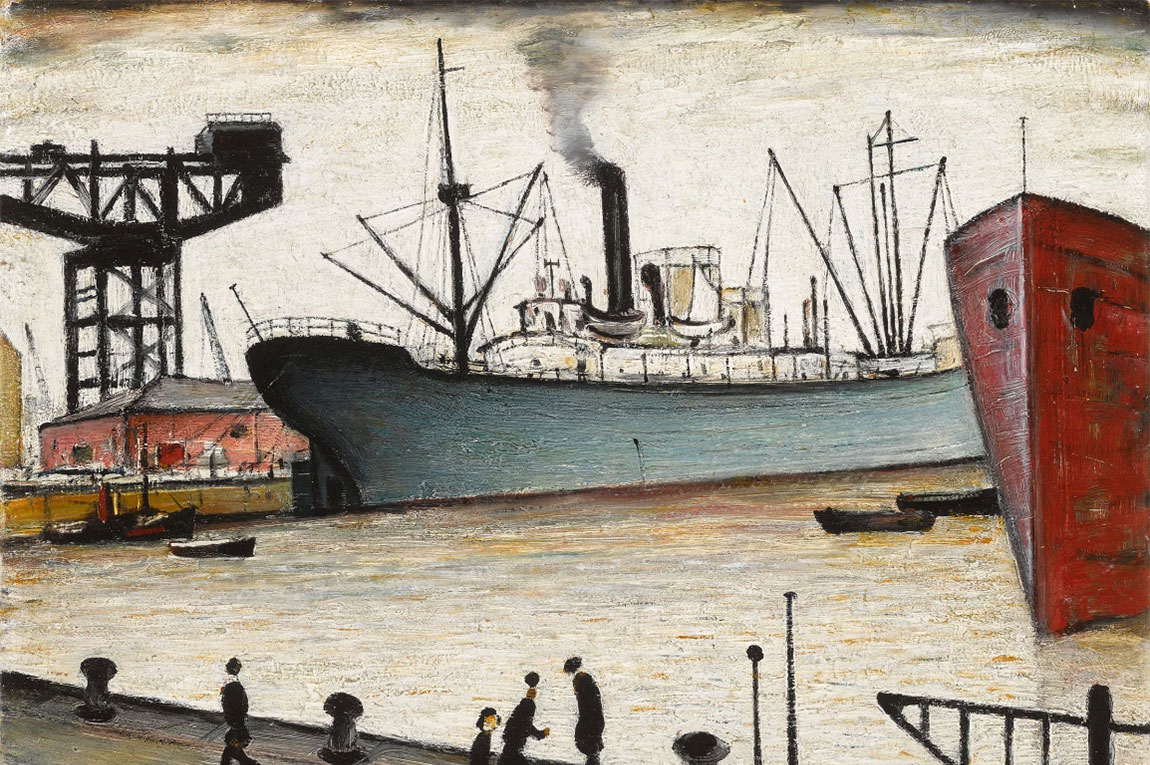 A selection of superb L.S. Lowry paintings exemplifies the remarkable skill and dry-eyed sensitivity of the renowned and much-loved chronicler of industrial labour in Great Britain.
A selection of superb L.S. Lowry paintings exemplifies the remarkable skill and dry-eyed sensitivity of the renowned and much-loved chronicler of industrial labour in Great Britain.
No artist has become as synonymous with 20th-century British workers as L.S. Lowry. His instantly recognisable figures, leaning into the wind as they go about their daily business amongst the factories, smokestacks and looming mills of Northern England have become emblematic of British industrialisation, and the lives of ordinary working people. Almost half a century after his death, his is an enduring legacy. Several covetable pieces are coming to auction at Sotheby’s Modern British & Irish Art auctions, certain to appeal to aficionados as well as those coming to his vision of the industrial North for the first time.
As Sotheby’s Charlie Minter says: “For many today, with no experience of this particular time, Lowry’s paintings will be the first evocations of this period of post-industrial Britain. They are doors to a world now gone in Britain, but whose impact is still sharply felt in British culture. And they are some of the most vivid doors – full of characters and moods which are compelling.”
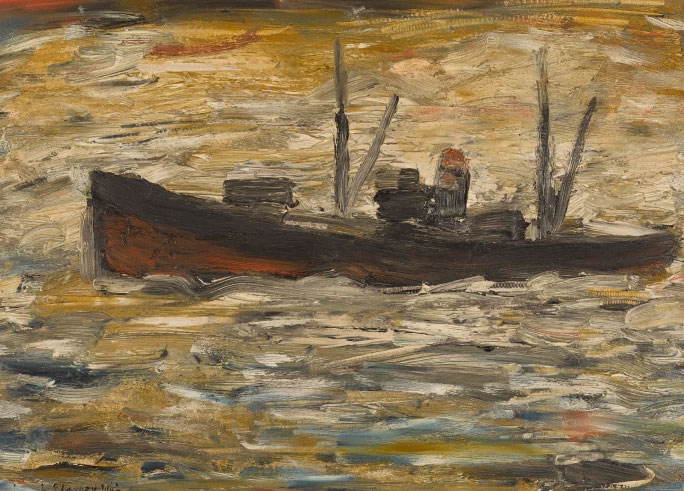
Lawrence Stephen Lowry was a solitary figure – a lifelong bachelor, known for his eccentricities and idiosyncrasies. For example, he always wore a black tie as, “it saves choosing between colours”. He listened to opera as he painted, never went abroad, never owned a car and, according to one memoir, had a telephone that barred incoming calls.
Born in 1887, Lowry initially grew up in the middle-class outskirts of Manchester but after his father suffered financial troubles, the family moved to live amongst the factories and cotton mills of Pendlebury. This would be the scenery he would dedicate much of his life to painting. With a muted colour palette – flake white, ivory black, Prussian blue, yellow ochre and marks of vermillion to lead the viewer’s eye through his compositions – Lowry painted the world he saw around him. Rather than topographical representations, these banks of scenes drew on his memories to create carefully structured composite views that balance the various elements between buildings, chimneys, streets and crowds, as seen in the lively dockside scene of Queens Dock, Glasgow, which features pedestrians strolling along a busy quay.
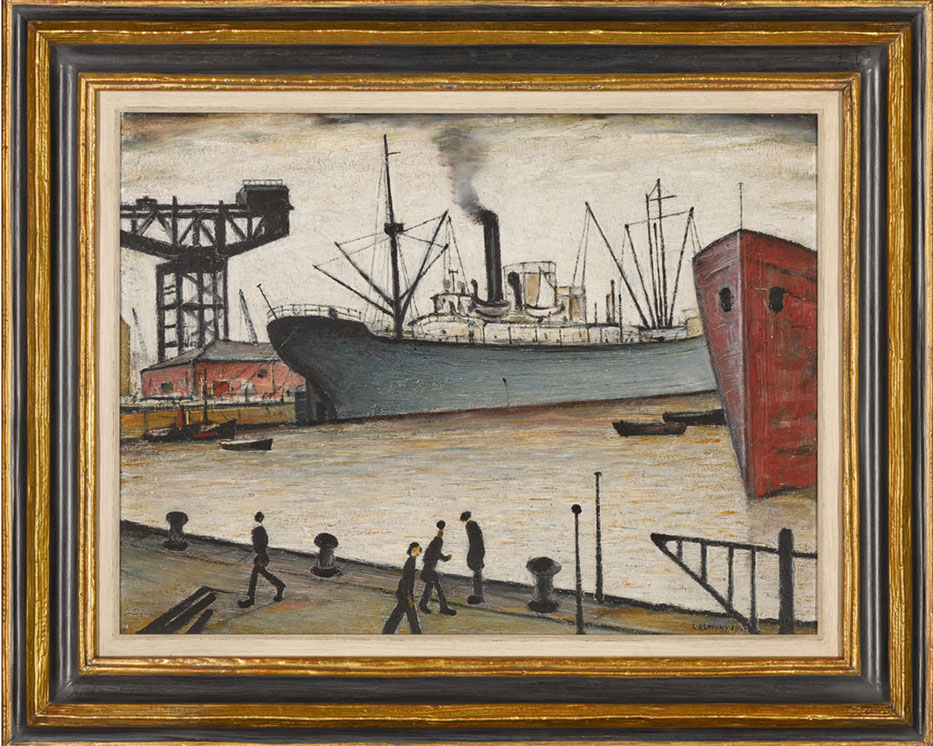
“My ambition was to put the industrial scene on the map because nobody [before] had done it seriously.”
In Pendlebury, Lowry saw value in the ordinary humdrum of everyday life. His hordes of almost identical workers, moving en masse, nod to the monotonous and regimented nature of their factory work. Often referred to as “matchstick figures”, Minter says this term “diminishes Lowry’s technical proficiency. He was an arduous student who attended art classes for years to hone his skills. These figures are a deliberate stylistic approach – one of several techniques he employs along with the use of a chalk white ground forming the base of his works and the absence of shadows, which gives the works their distinctive atmosphere.”
The dismissal of Lowry’s talent by some critics stemmed, in part, from the fact that he was never a full-time painter and worked as a rent collector until his retirement. And yet, Lowry was well trained, having taken evening classes at the Manchester Municipal School of Art, the Salford School of Art and studying under French Impressionist Adolphe Valette at the Manchester College of Art, an experience he later summarised thus: “In my own opinion I owe everything to the drawing I used to do at the art school, first the antique drawing and then the life”.
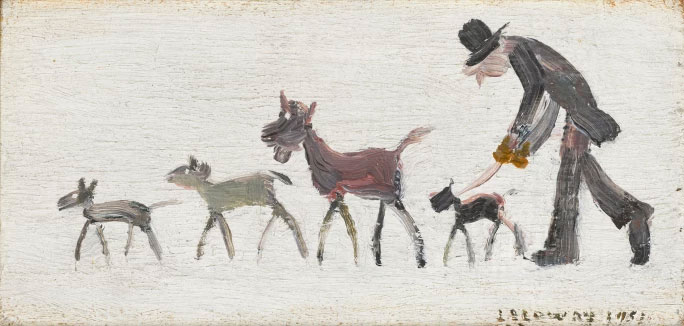
Despite the criticism, Lowry achieved great renown in his lifetime. In 1962, he became a member of the Royal Academy and he repeatedly turned down offers of a knighthood, stating, “all my life I’ve felt most strongly against social distinction of any kind”. A Royal Academy retrospective of his work, which took place a few months after his death, aged 88, in 1976, remains the most popular show by a 20th-century artist in the institution’s history.
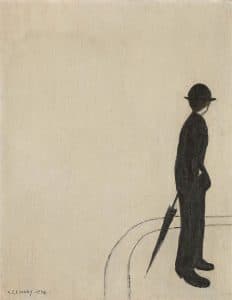
His oeuvre is also more varied than many realise. Following the end of the Second World War (during which time he was on fire-watch in Manchester), he turned his attention away from the city as a primary subject matter, towards melancholy seascapes and rural landscapes. Initially, these scenes featured holiday makers and day-trippers, but through the 1950s and 1960s, Lowry’s characteristic crowds thinned, and the scenes became so empty of human presence that they sometimes appeared almost abstract in nature. One such example is A Man Waiting, with its sparse curb separating a dark figure from a vast open plane.
He was also an accomplished portrait artist, and although these are less familiar than his urban scenes, Minter asserts they are no less striking. “He shows the same powers of observation, and indeed the works are often charged with a greater intensity as Lowry unflinchingly applies his acute powers of observation on individual characters. The people who inhabit the more anonymous crowds of his paintings became objects of individual scrutiny in his later career, the architectural settings drifting away.”
“Once you have seen how Lowry saw us, you cannot ever see, or be in a football crowd, nor watch kids playing, workers leaving the factory, queuing, or stopping to chat or hear the fairground barker, without saying, ‘Lowry! It’s just like a Lowry painting!’ Going about our business or pleasure, we are all subjects of his vision.”
This is evident in his famed 1938 portrait, Head of a Man (With Red Eyes) in which Lowry immortalised the people he lived and worked amongst. These portraits, tending to be of types, rather than individuals, reveal Lowry’s “lifelong fascination with society and the human form,” according to Charlie Minter. “These portraits become a means of self-analysis: self-portraits by an artist looking back on his life and career. It is perhaps not surprising to learn that Lowry was deeply taken with the psychologically charged, up and coming artist Lucian Freud, buying the artist’s 1944 Portrait of a Young Man for his own collection.”
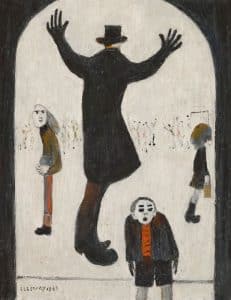
Since his death, Lowry’s work has only grown in popularity. In 2000, a purpose-built arts complex, The Lowry, was opened in Salford Quays, just three miles from his Pendlebury home, housing the largest collection of his paintings in the world. Meanwhile, in 2013, the Tate Britain hosted a retrospective titled Lowry and the Painting of Modern Life.
Over the years, Lowry’s work has continued to generate great excitement on the auction market. His evocative 1938 painting, A Cricket Match, sold at Sotheby’s for £1.1 million in 2019, while another sporting work – 1953’s Going to the Match, sold for £2.9 million last year. Perhaps most fittingly, the artist’s 1958 work, The Auction – the only known example of Lowry depicting an auction room – was sold at Sotheby’s in November 2021 for £2.6 million.
As Minter concludes, this is an artist and a body of work that has become an essential reference point in the social and historical understanding of industrialised Britain.
“Lowry offers an uncompromising, humorous, tragic, honest commentary of working-class Britain’s industrial North. His style of painting was so unique, and is so immediately recognisable, his works continue to pull audiences in a way that other artists’ work does not. Whether you like Lowry or not, you know what a Lowry is – and their power is hard to resist.”
POSTED WITH PERMISSION. COPYRIGHT SOTHEBY’S. Click to read original article.

